The apparent benefits of mobile apps have made them a rage, and a trend no-one can ignore. Eventually, cross-platform app development became highly popular in enterprise mobility, and everyone began to learn the benefits of launching hybrid programs.
Xamarin is a cross-platform application developed tool owned by Microsoft, and it contains a plethora of resources to help you build cross-platform mobile applications. Microsoft Azure cloud services help you deploy very powerful and scalable applications and APIs. Together with Xamarin, this cloud service provides developers with robust tools and services to build, test and deploy apps and update them. They can use their choice of language and tool to tap into these cloud services, and scale their apps whenever required to accommodate millions of new users or according to demand. In this article, we will look at how Azure services can be integrated with Xamarin to develop cloud powered mobile apps.
Consumers generally prefer to use mobile apps when compared to websites because it gives them the convenience of accessing them through their smartphones. However, the challenge with developers is that they have to develop apps so they would function optimally for all mobile platforms, especially Android, iOS and Windows. In the initial days, it was not possible for a single application to run on all the platforms because of compatibility issues. This is where Xamarin comes in as it provides the tools to build and deploy cross-platform native mobile apps.
While Android phones are Java based, iOS programming requires knowledge of Swift or Objective-C. Xamarin is the best solution for this because you don’t have to develop different apps for different platforms, but rather share the same code to create apps that provide the same performance as native apps. The platform does this by leveraging the .NET framework and compiling your code to a native binary for each of the platforms.
Cloud powered apps leverage the power of cloud to store its data. For example, the photos that you pull from your Instagram page are all stored in the cloud, and the images and posts that you see on Facebook when you open the news feed are also taken from the cloud.
There are two main terminologies that are important in a cloud connected mobile app:
(1) Mobile client - This refers to the piece of code run on your Android or Apple device.
(2) Mobile backend - This is the service you run in the cloud to cater to the mobile client’s requirements.
Microsoft Azure offers a number of cloud services that would help you power mobile apps. This way you can scale anytime you want and run a variety of APIs.
Apps should be scalable because they have to cater to sudden bursts of requests and demands. Traditional hosting models may not be able to handle them, and they might not have the extra resources needed for running the application. Azure can autoscale as and when required.
Microsoft Azure offers a plethora of features like user authentication, push notifications and offline data sync. User authentication helps in the sign-in functionality for your app, so users can effortlessly and conveniently access it. Push notifications lets you send personalized messages to all your users. Offline data sync is helpful because your users can access their app without any hindrance, even if they don’t have a live internet connection.
Azure provides secure and seamless connectivity to on-premises and cloud systems so your users will never have issues while connecting to their apps, irrespective of where they are.
Users can store any type of data through Azure cloud services, irrespective of whether they are file data, structured data sets or queries. They can share this data across virtual machines through standard SMB 2.1 protocol.
Developers can integrate Xamarin with different SDKs of mobile operating system. For example, you can integrate Android SDK and GDK with Xamarin Studio to create an app. Xamarin.Android supports modern devices like Amazon Fire Phone, Google Glass, Android Wear, etc.
By integrating sophisticated mobile DevOps processes, tools and systems, you can get the app into the users’ hands quickly. Provided by Visual Studio, Azure, Xamarin Test Cloud and HockeyApp, it is easy to boost the productivity and quality of your application.
Let’s take a deeper look into some of the important features offered by Azure services that you can integrate with an app built using Xamarin framework.
Azure App Service Authentication is an amazing feature capable of producing turnkey solutions to developers to aid in the authentication of mobile and web app users. Through minimal development efforts, you can present an app to the users that can be accessed through a single sign in process. The feature uses federated identity, wherein a 3rd party identity provider saves all the accounts and authenticates users.
Five such identity providers are commonly used: Azure Active Directory, Microsoft Account, Twitter, Facebook and Google. Apart from this, you can also add your own, customized identity solution.
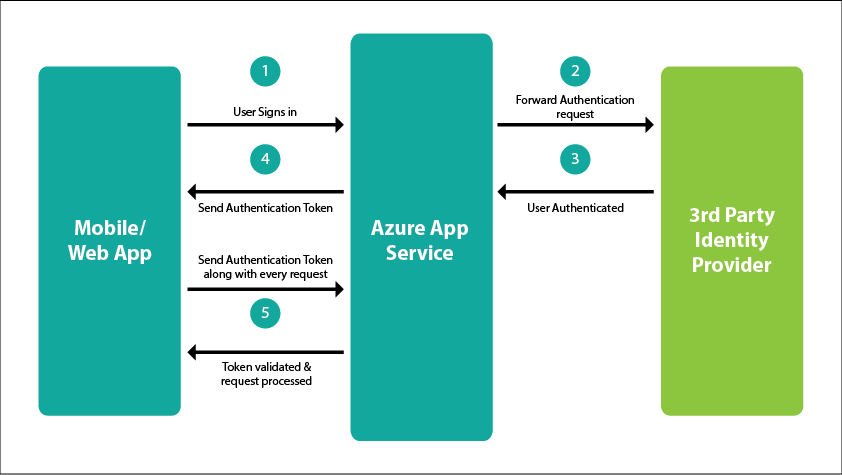
To ease the process, both the authentication and the authorization module runs in the same sandbox as the application code. All incoming HTTP requests pass through this module before it reaches the application code.
To authenticate users with a particular provider, you have to configure the required identity providers so they know your application. Your users can use one of the identity providers, for example, Twitter and he signs in with the built-in authentication mechanisms. This request is forwarded to the concerned identity provider.
Next, the identity provider will authenticate the user and relay information to Azure App Service. This will generate a unique token identifier, verifying the visitor as an authentic user of the application. The token identifier is a JWT or JSON web token, and will be presented in x-zumo-auth HTTP header.
The user receives this token, and will use it every time he needs to access other features within the application. If the token is not valid, then an unauthorized error is returned. Once the authentication is complete, the token store containing a repository of tokens is available to the app. Tokens like ID tokens, access tokens and refresh token are cached so only the authenticated users will be able to access it.
These tokens are refreshed and validated by the App Service to help authenticate users, and restrict who can see application.
Error handling is also done in a better way by enabling application logging. The authorizing is traced directly to the log files to check the source of the discrepancy.
It is important to devise new methods of communication to drive user engagement. Push notifications play a very powerful role in this regard, so you can easily send mobile notifications from anywhere. They help you send location specific coupons, new product announcements and launches, breaking news, etc. to your users.
Push notifications are useful, not only in enterprise apps where you need them to increase employee responsiveness for conducting various business events, but it is also a critical component in consumer apps. Sending one push notification to a single user is easy, but sending messages to millions of devices is no piece of cake.
Azure Notification Hubs helps you send the notifications from any backend, whether it is in the cloud or in-premises. Its flexibility lets you connect it to Microsoft, PHP, .NET, Java or Node.js. This gives you the freedom to engage your users in a better way and update them whenever required.
These notification hubs can be scaled to greater levels and you can send personalized notifications to any device - iOS (Apple Push Notification Service), Google (Google Cloud Messaging), Kindle or Windows (WPNS or Windows Push Notification Service). This helps you send notifications to different platforms. Through a single API call, you can send messages to an individual or a group of people, irrespective of the device they use, and at the same time.
Delivery of push notifications is traditionally done through platform-specific infrastructures called Platform Notification Systems (PNSes). It would be dependent on the platform in question and developers would have to work with Apple Push Notification Service (APNS) for iOS, Firebase Cloud Messaging (FCM) for Android and Windows Notification Service (WNS) for Windows.
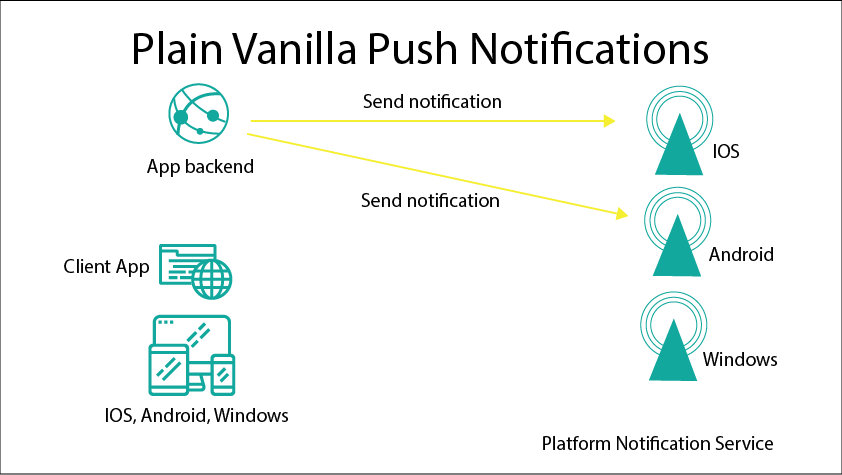
Notification Hubs eliminates the complexity of pushing notifications on your own from the app backend, thereby reducing and simplifying it completely.
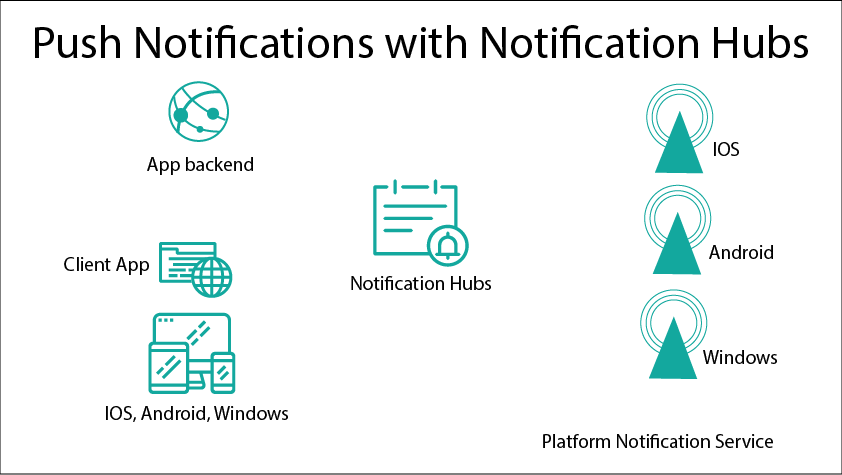
With the help of Notification Hubs, you no longer have to worry about sending notifications to your users from the app backend as the complexity is completely removed.
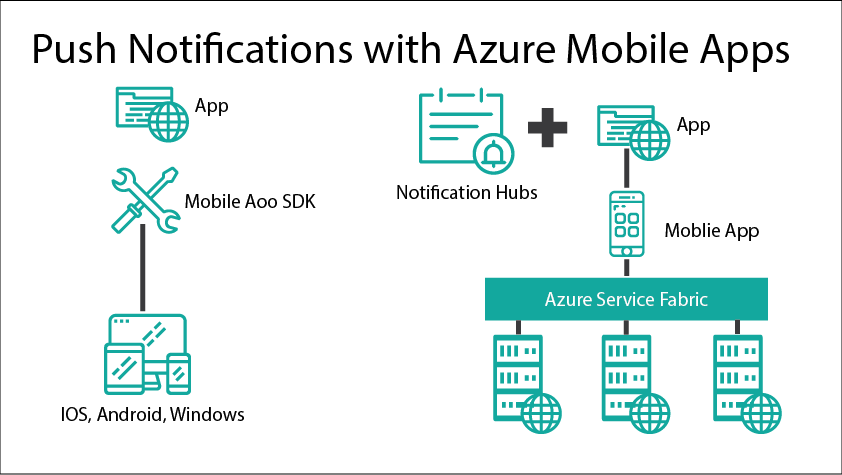
Notifications Hub can be add to the mobile app backend. Once the app is registered for push notifications, the backend can be be easily configured to send notifications irrespective of the target users’ device and platform.
Azure Storage is the Microsoft’s one stop solution for all cloud storage requirements. It acts as a file system service for cloud, messaging store for sending messages and a scalable object store for data objects, and more.
Durable and highly available
Hardware failures are nightmares that plague developers/companies as far as their data is concerned. Through redundancy, you can ensure the safety of your data. You can also replicate and distribute the data across different data storage centres in order to provide additional protection, in case of outage.
Security
Security is paramount with the data saved in Azure Storage. This data is encrypted and you have greater level of control on who has access to your data.
Scalable
The applications of today have changing requirements, especially during sudden bursts of demand. Seamless scalability is important in such cases, and Azure Storage plays an important role in making this happen.
Managed
There is no need to worry about critical issues plaguing the performance of your app at any time, because Azure Storage manages it for you. It can handle any critical issues and be prepared for emergencies.
Accessible
Accessibility is no longer an issue because the storage solution can be accessed from anywhere in the world through secure connections.
Other features include:
- .NET, Java, Node.js, Python, PHP, Ruby, Go support
- Azure PowerShell or Azure CLI for subscription and
- Azure Portal and Azure Storage Explorer visual solutions for working with your data.
Azure Blobs
Blob has the capacity to store hundreds of billions of data in a tiered basis, and depending on how often the data is accessed, they are termed hot and cold. Now you can store any amounts of unstructured data that come as videos, documents, audio and other formats. Data is stored for a variety of purposes - for archiving, as backup in case of disaster, for doing analysis or for serving images directly to the browser. This data can be accessed from anywhere in the world.
Azure Files
Microsoft Azure File Service is a cloud storage service that lets the administrators set up network file shares, and these would be accessed using SMB protocol (Server Message Block). Several VMs can access, read and write the same files at the same time, from anywhere in the world. It is also possible to generate SAS or Shared Access Signature tokens to restrict access.
Azure Queues
The queue storage is where you store and retrieve messages. The maximum size of each message can be 64 KB in size, and a single queue can hold millions of messages. The facility provides programming libraries for various languages. A main use of the queue would be to create a backlog of work that can be processed asynchronously. Another use is to pass messages from Azure web role to Azure worker role.
Azure Tables
Azure Table storage is a NoSQL datastore which stores huge amounts of structured data, and it can accept authenticated calls from both inside and outside Azure cloud. It is possible to store TBs of structured data that helps in scaling web applications. Table storage is also good for storing datasets that don’t need foreign keys or complex joins.
Disk Storage
When you need to conduct mission critical applications or complex test scenarios, you can rely wholly on Azure disk storage. You can choose SSD for I/O intensive applications since high throughput and low latency are very important. For testing applications, you can choose Standard Disk Storage as it aids in scaling up and down, while controlling costs.
Offline data sync is a client and server SDK feature from Azure that allows developers to make their apps available even during network connectivity issues. The biggest benefit is that you can create and modify the data within the app while in the offline mode. These changes will be saved in the local store, and once the device gets back online, the changes will be synchronized with the Azure Mobile Apps, after checking for conflicts. If conflicts are there, they will be handled on either the server or the client.
Through Offline Data Sync feature, developers can solve network connectivity issues with a few lines of code. This way they can push and pull data on demand. The data is recovered from the local storage automatically.
Improved responsiveness
Local caching in Azure Storage helps in the responsiveness of the app, so users can always access the app even when there is connectivity problem.
Help develop robust apps
Connectivity issues will no longer affect the quality of your app because the user can access the app anytime they want. This helps in the robustness of app performance.
Sync data
Azure Mobile Apps help in syncing data across several devices, and spot and understand conflicts as and when they occur. Another advantage with offline sync feature is that it limits network use in metered connections, in order to ease app usage.
Offline synchronization works with sync tables like IMobileServiceSyncTable (.NET client SDK) or MSSyncTable (iOS client). To add offline sync, both the backend and the front end client code will have to be modified. The local changes are then synchronized with Azure Mobile App backend. However, the data will get sent only when there is a call to “push” the local changes.
And likewise, the local store will have the new data only when there is a “pull” call. Suppose the mobile client object is IMobileServiceClient or MSClient, the changes made with sync tables are tracked. When you use the Sync Table, the CRUD operations of Create, Read, Update and Delete work from a local store, and the implementation is device platform specific.
All the changes made in these Sync Tables are tracked through a sync context object, and they remain in an ‘operation queue’ (the queue contains an ordered list of CRUD operations regarding the data, but performed locally), until they are sent to the server.
Here are the main operations involved in the action:
Push - An operation on the sync context that will send all the CRUD changes to the server. The Push function executes a series of REST calls to the Azure Mobile Backend to modify the server database.
Pull - This operation is done on a per table basis, and can be customized to “bring in” only a subset of the data in the server. The change will be inserted into the local store through Azure Mobile client SDKs.
Implicit Pushes - This operation will minimize the conflicts that might occur in the “pull” operation, especially with the data that is already queued and fresh new data in the server.
Incremental Sync - A pull operation’s first parameter is ‘query name’, which is used only on the client. The Azure Mobile SDK performs an incremental sync function when you use a non-null query name. The ‘pull’ operation brings back a number of results and if there is a timestamp, you will be able to retrieve only the latest results from the SDK local system tables.
Purging - The main function of this operation would be to ‘remove’ the contents of the local store. It clears the table from stale data, thereby keeping it filled with only fresh and useful data.
Enterprises are looking for new ways to enhance their applications by making their apps better through added functionalities. For this purpose, you have Microsoft Cognitive Services with APIs, SDKs and services giving you the freedom to make powerful and intelligent apps with just a few lines of code. Machine learning through artificial intelligence is a powerful means to bring intellect into your applications, and you can release a unique product, incorporating emotion and video detection, speech and vision recognition, speech and language understanding and facial understanding features.
A skim through of the various Cognitive Services APIs:
Vision is a feature that allows apps and its related services to correctly identify and analyze content and find out the visuals within them. This helps in image classification through computer vision, face vision where faces are detected and identified, including understanding their emotions and recognizing people standing within a group, and so on. You can also include a content moderator to identity and filter offensive images and videos. Images and videos can be customized to suit the information requirements of the user.
Through the ‘Speech’ feature, it is possible to integrate speech processing requirements within the app. This way, the user can convert spoken content into text and vice versa. The speech recognition capabilities makes it easy to detect, recognize and verify the user’s voice in real time. Real time translation is also possible.
How about apps having the capacity to understand the user’s language like a native speaker, evaluate the sentiments within the statements and bring out results based on what users want? You can teach the apps to understand user commands, translate and even spell check them, so the user gets a complete product.
The knowledge of the Cognitive API allows you to distill information and deliver intelligent information which the users can easily navigate. This is a cloud-based contextual decision making API that easily gives awesome results to the user.
With the plethora of information found online, it is a very powerful and dynamic functionality to search and retrieve what the user commands. Cognitive Search APIs of Azure sifts through millions of web pages, images, videos and news search results to deliver what is needed.
With these amazing features provided by Microsoft Azure, you can easily leverage the power of Xamarin to create dynamic cloud-powered, cross-platform apps and scale them to reach millions of customers. And that’s not all. If you want to communicate any information about your product and are worried about whether it will reach the right target segment, Azure can help you reach your users. The apps are built with full native performance through Xamarin, giving the user-engagement and performance that you desire, even when there are connectivity issues.
Being one among the Best Chicago Software Development Companies ,Let us help you power up your cross-platform mobile app development with Xamarin and Azure cloud services.
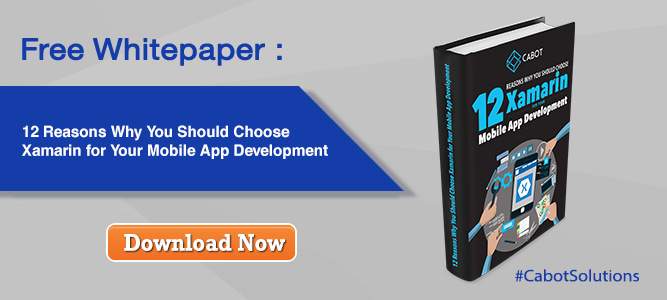

YOU WILL BE HEARING FROM US SOON!
We look forward to hearing from you!

YOU WILL BE HEARING FROM US SOON!